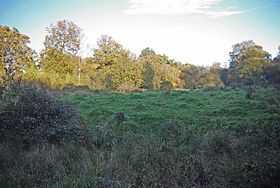Portingbury Hills
| Portingbury Hills | |
|---|---|
 Portingbury Hills (Photo by Glyn Baker) | |
| Location | |
| Location | Hatfield Forest, Little Hallingbury, Hatfield Broad Oak, England |
| OS grid | TL5320 |
| Coordinates | 51°49′38″N 0°14′33″E / 51.82712°N 0.24257°ECoordinates: 51°49′38″N 0°14′33″E / 51.82712°N 0.24257°E |
| Topo map | OS |
Portingbury Hills (grid reference TL5320) or Portingbury Rings is a hill in Hatfield Forest, Little Hallingbury, Hatfield Broad Oak, Essex, suggested to date to the Iron Age or Bronze Age.[1] It consists of a 3 features, a hill and mound connected by a zig-zag causeway formed by 2 almost parallel ditches to another rectangular enclosure measuring 30 x 21 metres (100 x 70 ft) surrounded by a large ditch with a suggested bank up to 11 metres wide (35 ft). It is located in the northwest of Hatfield Forest in Beggarshall coppice. It has been considered to be an ancient defensive enclosure, but is too small to be a hill fort and is not in a defensible position.[2]
Archaeological excavations were carried out in 1964-1965 with recovered evidence including a small flint blade 4 cm long, animal bones, flints, and charcoal with very slight dating evidence suggesting Iron Age construction. The archaeologists suggested that the initial, ‘V’ shaped, ditch surrounding the mound would have been approximately 2 metres in depth suggesting it once had earth ramparts supported by timber. Smaller banks have been noted to cross Shermore Brook to Spittlemore coppice.[3]
In 1975 retired geologist and researcher Christian O'Brien suggested that Portingbury Hills had a purpose in archaeoastronomy and was constructed in the Bronze Age which gave it some brief coverage in the Sunday Telegraph. O'Brien suggested that the mound was aligned astronomically with Wandlebury Hill via a series of equally-spaced, hand-carved, stone monoliths forming a Loxodrome. Eleven of the original twenty-six markers are still in situ, such as the Leper Stone, with several of the other distinctive stones lying nearby.[4] O'Brien's theory met with mixed reviews from astronomers and archaeologists.[5] Glyn Daniel, Professor of Archaeology at Cambridge University dismissed the paper as "nonsense" and Alexander Thom could find nothing in it to revise the documented view of Wandlebury as an Iron Age Fort. Archie Roy, Professor of Astronomy at Glasgow University commented that "in the absence of a more convincing explanation, this conclusion also has to be taken very seriously.” [6][7]
References
- ↑ W. R. Powell (1983). A History of the County of Essex: Volume 8. Victoria County History.
- ↑ Huggins, P.J., 1978, 'Pappus and Pontingbury' Essex Archaeological Society Transactions Vol. 10 p. 225-6
- ↑ Wilkinson, P., 1978, 'Portingbury Hills or Rings' Essex Archaeological Society Transactions Vol. 10 p. 221-4 (excavation report)
- ↑ "The Geology of Essex". Essex Wildlife Trust. Retrieved 2011-03-08.
- ↑ 'brien&dq=wandlebury+o'brien&hl=en The Antiquaries Journal, Volume 57, Oxford University Press, 1978
- ↑ Hoppit, David (1978). "The Wandlebury Enigma Solved? - Line A Loxodrome". Sunday Telegraph Magazine, Issue 78, March 18th.
- ↑ Wilson, Colin (1980). Starseekers. Doubleday. ISBN 0-385-17253-2. Excerpt from Google Books retrieved 6 March 2011.
Papers
- O'Brien, C.A.E., 1975, [http://www.goldenageproject.org.uk/wanddownload.html, The Wandlebury-Hatfield Heath Astronomical Complex], Thaxted.
External links
- National Trust - Hatfield Pre-Hunting Forest
- Hatfield Broad Oak Village web site
- Sunday Telegraph Article about Portingbury Hills Loxodrome